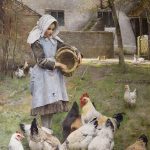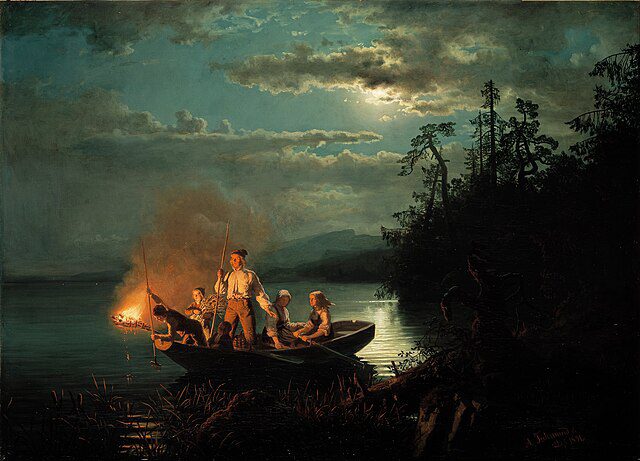
Hans Fredrik Gude was born on March 13, 1825, in Christiania, now Oslo, Norway. He grew up in a time when Norway was experiencing significant cultural and nationalistic changes. As a young boy, Gude showed an early interest in art, which his parents encouraged. His father, Ove Gude, a prominent lawyer and politician, ensured that Hans received a good education and the opportunity to pursue his artistic inclinations.
Gude’s formal training in art began at the age of 12 when he studied under Johannes Flintoe, a notable Norwegian painter. Flintoe was an influential figure in Gude’s early development, teaching him the basics of drawing and painting. Flintoe’s guidance helped Gude develop a strong foundation in the technical aspects of art, which would serve him well throughout his career.
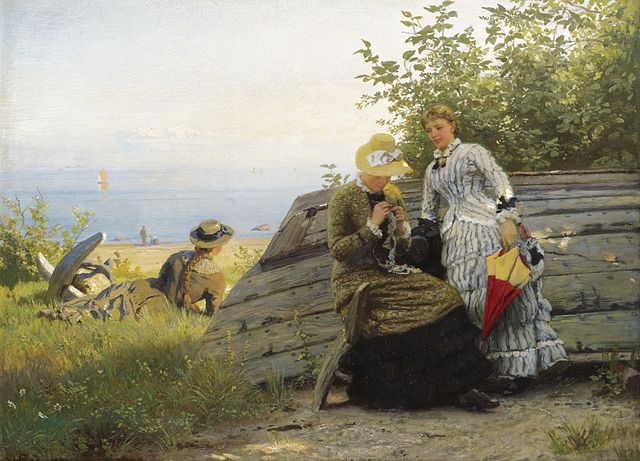
In 1838, Gude enrolled at the Royal School of Drawing in Christiania. Here, he honed his skills further and began to explore his interest in landscape painting. His teachers recognized his talent and encouraged him to continue his studies. Gude’s time at the Royal School of Drawing was pivotal, as it marked the beginning of his formal education in the arts and introduced him to the broader world of European art.
In 1841, at the age of 16, Gude traveled to Düsseldorf to study at the Düsseldorf Academy, one of the leading art schools in Europe at the time. The Academy was renowned for its emphasis on landscape painting and its rigorous academic training. Under the mentorship of Johann Wilhelm Schirmer, Gude refined his techniques and developed his distinctive style. Schirmer’s influence was crucial in shaping Gude’s artistic vision, particularly his focus on the romantic and dramatic elements of nature.
The Düsseldorf School and Artistic Development
Hans Gude’s time at the Düsseldorf Academy was transformative. The Academy was the center of the Düsseldorf School of painting, a movement that emphasized meticulous detail, realism, and a romantic interpretation of nature. Gude quickly became a prominent member of this school, mastering the techniques and philosophies that defined it.
One of the key aspects of Gude’s artistic development during this period was his collaboration with fellow Norwegian painter Adolph Tidemand. Together, they created several iconic works that combined Tidemand’s skill in figure painting with Gude’s mastery of landscapes. Their most famous collaboration, “Bridal Procession on the Hardangerfjord” (1848), is a masterpiece of Norwegian Romanticism, showcasing the dramatic beauty of Norway’s landscapes and the cultural richness of its people.
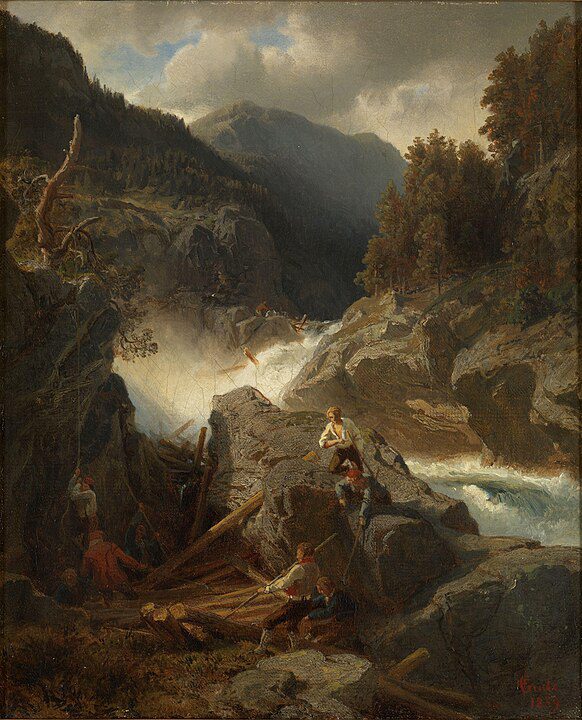
Gude’s work during his time in Düsseldorf was characterized by its attention to detail and its ability to capture the sublime beauty of nature. He often depicted the rugged terrain of Norway, with its fjords, mountains, and forests, in a way that highlighted the majesty and power of the natural world. His paintings from this period are marked by a sense of awe and reverence for nature, reflecting the Romantic ideals that were prevalent in European art at the time.
In addition to his collaboration with Tidemand, Gude also developed his individual style. He experimented with different techniques and compositions, gradually moving towards a more naturalistic and less idealized representation of landscapes. This evolution in his style was influenced by his observations of nature and his desire to depict it as faithfully as possible. Gude’s meticulous attention to detail and his ability to capture the changing moods of the landscape made his work stand out.
By the early 1850s, Gude had established himself as one of the leading landscape painters of his generation. His reputation extended beyond Norway and Germany, with his works being exhibited in major European art centers. The success he achieved during this period laid the foundation for his future endeavors and solidified his position as a central figure in the Romantic movement.
Teaching Career and Influence
In 1854, Hans Gude returned to Norway, where he took up a teaching position at the Royal School of Drawing in Christiania. His return marked a new phase in his career, as he began to influence the next generation of Norwegian artists. Gude’s teaching philosophy emphasized the importance of direct observation of nature and the need for technical proficiency. He encouraged his students to study the landscape closely and to develop their own artistic voices.
Gude’s impact as a teacher was profound. Among his students were several who would go on to become prominent artists in their own right, including Frits Thaulow and Christian Krohg. Gude’s emphasis on realism and his dedication to capturing the essence of the Norwegian landscape resonated with his students, many of whom carried these principles into their own work. Gude’s influence extended beyond his immediate students, as his teachings helped shape the broader direction of Norwegian art during this period.
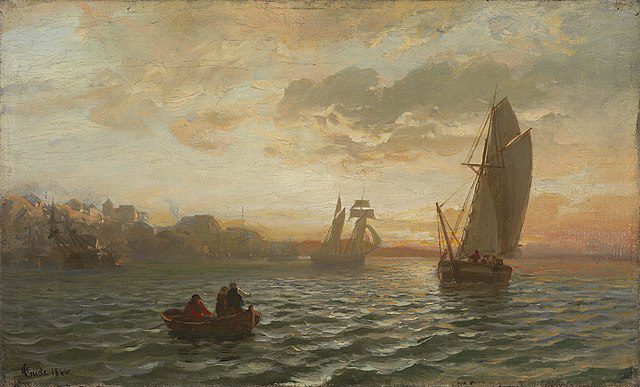
In 1864, Gude accepted a position as a professor at the Karlsruhe Academy of Fine Arts in Germany. This move allowed him to expand his influence and to engage with a broader community of artists. At Karlsruhe, Gude continued to emphasize the importance of landscape painting and to promote the values of the Düsseldorf School. His tenure at Karlsruhe was marked by a series of successful exhibitions and the development of a strong artistic community.
Gude’s influence was not limited to his role as a teacher. He also played a significant role in promoting Norwegian art internationally. Through his connections in Germany and other European countries, he helped organize exhibitions of Norwegian art and introduced European audiences to the beauty and uniqueness of the Norwegian landscape. Gude’s efforts in this regard were instrumental in raising the profile of Norwegian art and in fostering a sense of national pride among Norwegian artists.
In 1880, Gude moved to Berlin, where he took up a teaching position at the Berlin Academy of Arts. His years in Berlin were among the most productive of his career. He continued to paint, teach, and exhibit his work, further solidifying his reputation as one of the leading landscape painters of his time. Gude’s influence on the Berlin art scene was significant, and his legacy as a teacher and mentor continued to grow.
Artistic Achievements and Signature Works
Hans Gude’s artistic achievements are numerous and his works are celebrated for their technical excellence and emotional depth. One of his most notable early works is “Bridal Procession on the Hardangerfjord” (1848), created in collaboration with Adolph Tidemand. This painting is renowned for its intricate detail and the way it captures the cultural and natural beauty of Norway. The work became an icon of Norwegian national identity and is still celebrated today.
Another significant work is “The Ferry Boat” (1850), which showcases Gude’s ability to depict the interplay of light and water. The painting captures a moment of tranquility on a Norwegian fjord, with the ferry boat reflecting in the calm waters. The meticulous rendering of the landscape and the subtle use of color demonstrate Gude’s mastery of his craft. This work, like many others, reflects Gude’s deep connection to the Norwegian landscape and his ability to convey its serene beauty.
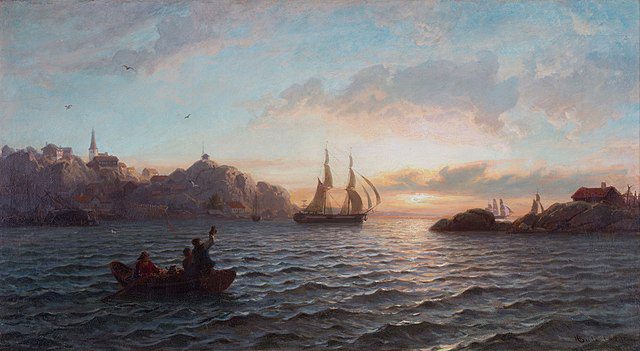
Gude’s “The Grindelwald Glacier” (1862) marks a departure from his earlier, more idealized landscapes. This painting is notable for its realism and the way it captures the rugged and awe-inspiring nature of the Swiss Alps. Gude’s ability to convey the sheer scale and majesty of the glacier is a testament to his skill as a landscape painter. This work highlights his evolution as an artist and his commitment to depicting nature with honesty and precision.
In 1874, Gude completed “Sunset over a Forest Lake,” a painting that exemplifies his mature style. This work is characterized by its rich colors and the way it captures the fleeting beauty of a sunset. The reflection of the sunset in the lake and the way the light filters through the trees create a sense of peace and harmony. This painting, like many of Gude’s later works, demonstrates his ability to convey the emotional impact of nature.
Gude’s body of work is diverse, encompassing a wide range of landscapes from Norway and beyond. His paintings are characterized by their attention to detail, their use of light and color, and their ability to convey the emotional and spiritual aspects of nature. Gude’s works continue to be celebrated for their beauty and their contribution to the Romantic movement in art.
Legacy and Impact on Norwegian Art
Hans Gude’s legacy in the world of art is profound. He is considered one of the foremost landscape painters of the 19th century, and his influence on Norwegian art is particularly significant. Gude’s commitment to capturing the beauty and majesty of the Norwegian landscape helped to shape the national artistic identity. His works are celebrated not only for their technical excellence but also for their ability to evoke a deep sense of place and national pride.
Gude’s role as a teacher and mentor was equally important. His dedication to teaching and his ability to inspire his students left a lasting impact on the next generation of artists. Many of Gude’s students went on to become prominent figures in Norwegian art, carrying forward his emphasis on realism and his appreciation for the natural world. Gude’s influence can be seen in the works of artists like Frits Thaulow and Christian Krohg, who continued to explore and develop the principles he taught them.
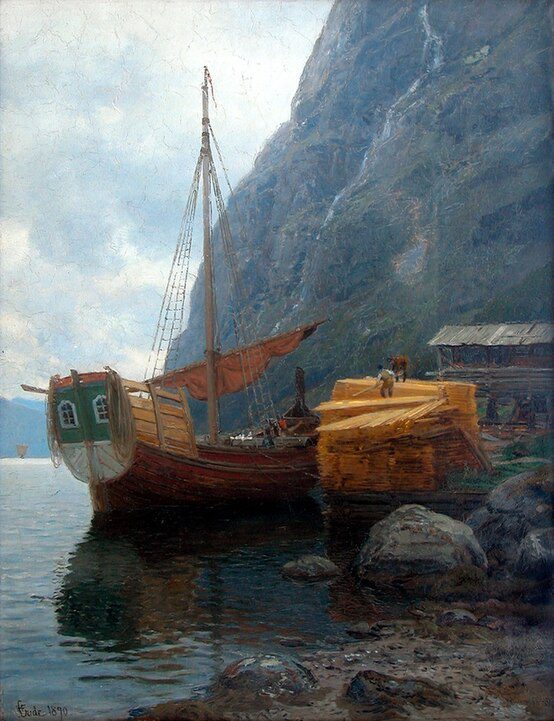
In addition to his contributions to art, Gude played a key role in promoting Norwegian culture internationally. Through his exhibitions and connections with artists and institutions across Europe, he helped to raise the profile of Norwegian art and to introduce European audiences to the unique beauty of the Norwegian landscape. Gude’s efforts in this regard were instrumental in fostering a sense of national pride and cultural identity among Norwegian artists and audiences.
Gude’s works continue to be celebrated and studied today. They are featured in major art museums and collections around the world, including the National Gallery in Oslo and the Louvre in Paris. His paintings are recognized for their technical brilliance and their ability to capture the sublime beauty of nature. Gude’s legacy is not only in the works he created but also in the impact he had on the development of Norwegian art and the broader Romantic movement.
Personal Life and Later Years
Hans Gude’s personal life was marked by his deep connection to his family and his dedication to his craft. He married Betsy Juliane Charlotte Anker in 1850, and the couple had eight children. Gude’s family life provided him with a source of stability and support, which was crucial for his artistic endeavors. His wife, Betsy, was a constant companion and supporter, playing a significant role in his personal and professional life.
Gude’s later years were spent in Berlin, where he continued to teach and paint. Despite the demands of his career, he remained deeply connected to Norway and often returned to his homeland to paint and visit family. His later works reflect a mature artist who had fully mastered his craft and who continued to find inspiration in the natural world. Gude’s ability to remain productive and creative throughout his life is a testament to his passion for art.
In 1880, Gude was awarded the title of Knight of the Order of St. Olav by the King of Norway, in recognition of his contributions to Norwegian art. This honor was a fitting acknowledgment of Gude’s impact and his role in shaping the artistic identity of his country. Gude’s achievements were celebrated not only in Norway but also in Germany and other parts of Europe, where he was recognized as one of the leading landscape painters of his time.
Hans Gude passed away on August 17, 1903, in Berlin. His death marked the end of a remarkable career that had spanned more than six decades. Gude’s contributions to art, his influence as a teacher, and his role in promoting Norwegian culture left an indelible mark on the art world. His works continue to be celebrated and studied, and his legacy lives on in the many artists he inspired and the countless landscapes he brought to life on canvas.
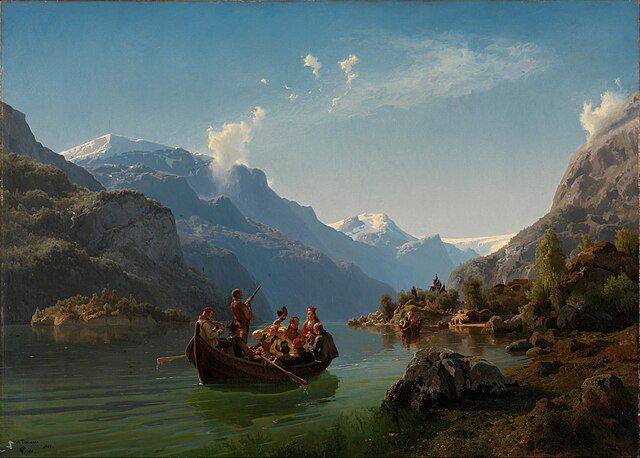
Hans Gude’s life and work exemplify the profound impact that one artist can have on their cultural and artistic landscape. From his early days in Christiania to his influential years at the Düsseldorf Academy, Gude’s journey was marked by a deep commitment to capturing the beauty of the natural world. His collaborations, teaching career, and numerous masterpieces have left a lasting legacy that continues to inspire and influence artists today.
Gude’s ability to blend technical skill with emotional depth allowed him to create works that resonate with viewers on multiple levels. His dedication to his students and his efforts to promote Norwegian art internationally have ensured that his influence extends far beyond his own body of work. As we continue to admire and study his paintings, we are reminded of the timeless beauty of nature and the enduring power of art to capture and celebrate that beauty.
In the words of Gude himself, “Nature is ever varied and full of beauty; it is the artist’s task to select and depict that which touches the heart and mind.” This philosophy guided Gude throughout his life and is evident in every stroke of his brush. His legacy is not only in the stunning landscapes he painted but also in the inspiration he provided to countless artists who followed in his footsteps. Hans Gude’s life and work are a testament to the enduring power of art and the profound impact of an artist dedicated to their craft.




